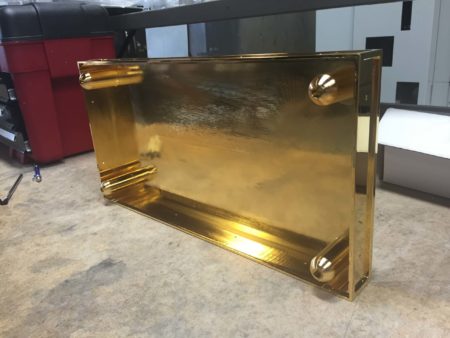Red Metal Material Highlight: Brass Machining
Brass, a non-ferrous member of the red metal family, was inadvertently invented in 500 BCE when early civilizations melted copper with calamine, a zinc ore.
However, brass wasn’t commonly used until the Industrial Age because zinc wasn’t a naturally occurring resource in many parts of the world. In the 18th century, a patent for manufactured zinc made it easier for metallurgists to make brass.
Today, this metal alloy is popular among manufacturers and artists alike as its properties are ideal for both mechanical and decorative purposes.
Properties of Brass
The properties of brass alloys can vary depending on the proportions of zinc and copper an alloy contains. The addition of other metals and elements can further alter the characteristics of brass.
Color
The base metal, copper, gives brass its warm reddish color. Zinc lightens and brightens the alloy, creating the light gold hue we recognize as brass today.
Increasing the amount of zinc makes brass lighter still. Other elements change the color of brass completely. Adding just 1% of manganese turns brass brown, and nickel gives it a silver appearance. Like copper, brass will oxidize and develop a light blue or green patina.
Strength and hardness
Brass is known for its hardness and durability, but adding tin makes it even stronger and harder.
A higher proportion of zinc also increases the strength of brass. High-strength brasses contain more than 39% zinc.
Ductility
Brass is easy to machine and takes plating well. It’s also easy to form. Zinc is what gives brass ductility; the higher the percentage of zinc in the alloy, the more pliable it will be. Lead can also be added to brass to make it softer and more malleable.
Melting point
Brass has a high melting point of approximately 900° Celsius. The exact melting point differs based on the concentration of different elements in the alloy. Brass reaches optimum heat resistance when the zinc content ranges from 32% to 39%.
Antibacterial
Brass is antibacterial due to the antimicrobial properties inherited from copper. Bacteria can’t survive on brass alloys, making these materials ideal for fixtures in bathrooms and medical facilities.
Corrosion resistance
Brass is highly corrosion resistant. When corrosion does occur, it’s often due to amine, a compound derived from ammonia. The amount of zinc in the brass can also impact corrosion resistance. Zinc can leach out of the alloy, rendering it more porous.
Common Applications for Machined Brass
Brass is uniquely suited to serve both functional and cosmetic purposes in various applications, including:
- Mechanical: housings, bearings, castings, pipes, slides, fittings, and valves
- Decorative: faucets, lighting fixtures, doorknobs and locks, hinges, furniture, and ornamental accents
- Musical: trumpets, tubas, french horns, trumpets, trombones, and baritones
Its tendency to tarnish and change color due to oxidation makes it seem more “alive” than other metals. Not to worry—the oxidation isn’t a problem. Anyone who’s been in an orchestra or has served in the military knows that brass polishes up nicely.
Common Types of Brass
There are over 60 documented types of brasses across three main families of brass. The three families denote the base materials:
- Copper and zinc
- Copper, zinc, and tin
- Copper, zinc, and lead
Brasses are categorized by the percentage of zinc present in the alloy:
- Alpha brass contains less than 37% zinc
- Beta brass contains over 45% zinc
- Alpha-beta brass (also known as duplex brasses) contain zinc in the range of 37%-45%
Many brass alloys are used in precision machining, but two of the most common are alloy 353 and alloy 360.
- Copper Alloy No.C35300 (“alloy 353” or “353 brass”). Alloy 353 consists of approximately 62% copper, 36.2% zinc, 1.8% lead, and trace amounts of iron. Also known as engraver’s brass, 353 brass has a tensile strength between 49,000 psi and 85,000 psi. Common parts made from this alloy include clock and watch components, valve stems, gears, cabinet and drawer handles, hinges, nuts, and screws.
- Copper Alloy No. C36000 (“alloy 360” or “360 brass”). With the highest machinability rating of all brass alloys, brass 360 is a perennial favorite among manufacturers. Alloy 360 contains 61.5% copper, 35.5% zinc, 3% lead, and 0.35% iron (approximately). Unlike steel and iron, 360 brass is highly resistant to corrosion and has a tensile strength of 58,000 psi. Common parts made from this alloy include screw machine parts, electrical equipment, plumbing components, musical instruments, and central heating parts.
Brass is a unique material with many beneficial properties, meeting the needs of a wide variety of industries. However, it is a heavy material, so it’s not suited for aerospace applications.
At KAD, we love working with interesting materials to make beautiful, functional prototype models. We’d love to hear from you if you’re curious about using brass for your next precision machining project. Submit a quote today to get started.



